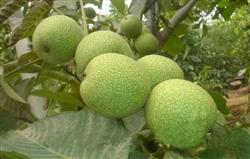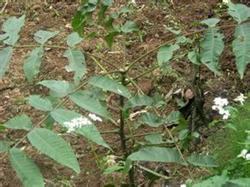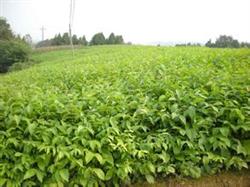Identification and Control of Walnut Diseases

The fungal disease of branch blight mainly harms the branches of walnut trees, causing withered branches and withering, and in serious cases, it can cause a large number of branches to die, which has a great impact on the yield. The disease begins with the young twigs and then spreads down to the trunk. The cortex of the damaged branches was dark gray at first, then light reddish brown, and finally dark gray, and formed many small black spots (that is, the conidium disk of the pathogen). The leaves on the diseased branches gradually turn yellow and fall off, and the branches die. When the humidity is high, the disease produces a large number of black short columns (that is, conidia). The pathogen overwintered in the diseased part with mycelium and conidia disk, and produced conidia under suitable conditions in the next spring and spread by wind, rain, insects and so on. Generally, the disease begins from May to June, and the peak period is from July to August, and the disease is serious in the years with weak branches and severe frost injury or spring drought. Prevention and control methods (1) agricultural control. Increase the application of organic fertilizer, enhance the tree potential, improve disease resistance; timely cut off diseased branches in the growing season and burn them; whitening the trunk in autumn to prevent frost injury; trunk disease, scraping off disease spots, and disinfecting the wound with 1% copper sulfate solution, external application of wound protective agent. (2) Pesticide control. From June to August, spray 1000-fold solution of 70% methyl topiramate wettable powder or mancozeb wettable powder every 10 days, 3-4 times in succession, and the effect is good. Rot disease, also known as Blackwater disease, fungal disease, mainly harms the branches and stems of walnut, prevents the transport of nutrients, resulting in weakening of tree growth, decline of knot strength, and death of the whole plant in serious cases. The symptoms vary with the age of the tree and the location of the disease. Young tree trunk and backbone branch disease spot at the initial dark gray, water stains, slightly swollen, the diseased skin turned dark brown, with the smell of wine lees. After the loss of water and subsidence of the diseased tissue, there are many small black spots on the disease spot. The disease spot developed vertically and horizontally along the trunk, and in the later stage, the skin split longitudinally and black water flowed out. when the disease spot surrounded the trunk for a week, the main branch or the whole plant of the young tree died. After the trunk of the tree is infected, it is hidden in the bark at the initial stage, and there are no obvious symptoms on the outside. when the disease spot expands, the bark cracks, black water flows out, and shines after drying, as if painted with a layer of black paint. After the vegetative branches or 2-3-year-old lateral branches were infected, the branches gradually lost green, peeled off the cortex and xylem, lost water and dried up. The pathogen overwintered in the diseased part with mycelium or sporangium and conidium. After the sap flows in the next spring, conidia are produced, which are transmitted by wind, rain and insects and invade from the wound. The main period of plaque expansion and bacterial activity was from mid-April to late May, and the second peak appeared in August until it stopped before overwintering. In general, walnut trees with barren soil, poor drainage, extensive management suffering from freezing injury and drought are prone to disease. Control methods: strengthen cultivation management, deeply turn and expand holes, increase the application of organic fertilizers, and reasonably apply nitrogen, phosphorus, potassium and trace element fertilizers to improve the nutrition level of trees and enhance the ability of cold resistance and disease resistance. Combined with pruning, the diseased branches, dead branches and dead trees of the orchard should be removed in time and burned centrally. White the trunk before the beginning of winter to prevent frost injury. Scrape the disease spot in time in early spring and growing season, and after scraping, apply 50% methyl topiramate or Baume 5-10 degree stone sulfur mixture to protect the wound. Canker fungal disease is mainly harmful to the trunk, twig and fruit of young walnut trees. it is brown and black nearly round spot with a diameter of 0.1-2 cm, which mostly occurs at the base of trunk and main side branches. Some expand into diamond-shaped or strip-shaped plaques. On the young and smooth bark, the disease spot is waterlogged or marked with blisters. After rupture, brown mucus flows out, and the air turns dark brown. Then there are many small black spots in the disease area. In severe cases, the disease spot is connected in the shape of diamond or long strip. When the disease department expanded to encircle the branch and dry for a week, the withered shoot, withered branch or the whole plant died. The epidermis of the disease was ruptured in autumn. On the older bark, the disease spot is mostly waterlogged, the center is dark brown, and the rot is as deep as the xylem. After the damage, the fruit showed brown spots of different sizes, early falling, dry shrinkage or black rot. The pathogen overwintered as mycelium in the diseased part, and began to move when the temperature reached 11.4-15.3 ℃ in the next spring. When the temperature was about 28 ℃ in late May, a large number of conidia formed and spread by wind and rain, and the disease reached the peak. When the temperature exceeded 30 ℃ in summer, the disease basically stopped spreading. When the temperature and humidity were suitable in autumn, the disease developed again, but not as serious as in spring. Orchards with poor soil, heavy clay, poor drainage, high groundwater level or extensive management, no fertilization, no pruning, freezing injury and insect pests are easy to occur. In addition, there are more diseases on the sunny side of the tree trunk. The control methods are to increase the application of organic fertilizer or plant green manure to improve the soil and enhance the tree potential. Reasonable pruning and shaping, improve crown structure and improve light energy utilization efficiency. White tree trunks in autumn and winter to prevent sunburn and frost injury. During the onset of the disease, spraying 70% methyl topiramate 800 times solution, etc., or cutting the diseased skin with a knife, reaching to the xylem, and then smearing with Baume 3-5 degree stone sulfur mixture, all have a certain effect.
- Prev

Cultivation techniques of Walnut
Cultivation value walnut is an important oil fruit tree with high economic value. Walnut kernel is not only rich in fat, but also high in protein, vitamins and a variety of minerals, which is often used as an advanced tonic and has a certain medical effect. The walnut kernel of our country is of good quality and high oil content, which is well received by the international market.
- Next

How to breed walnut seedlings in spring?
First, seed selection: select the fully mature seeds in the excellent varieties, so that the germination rate is high. That is, during the walnut harvest, most of the involucre (green skin) cracked and fell off on its own, or the involucre did not crack and fall off after about half a month of maturity. Second, seed treatment: at the beginning of March, the seeds to be bred will be sandy.
Related
- Moge, come on! The staff of the peasant association in the producing area of cantaloupe were frightened when the crowd gathered.
- Causes and Solutions of low Fruit setting rate of Apple
- Symptoms and control measures of passion fruit virus disease
- Fruit growing lesson: how do apple orchards keep high yields?
- Can you build orchards in the mountains? What are the pros and cons?
- How to manage the coloring period of Crisson grape?
- This paper introduces the processing technology of two kinds of fig products.
- How much is a month for retired teachers in rural areas by 2020?
- How can strawberry planting increase sugar content? We should pay attention to management in many aspects.
- What are the cultivation techniques on how to improve the yield of golden fruit?

